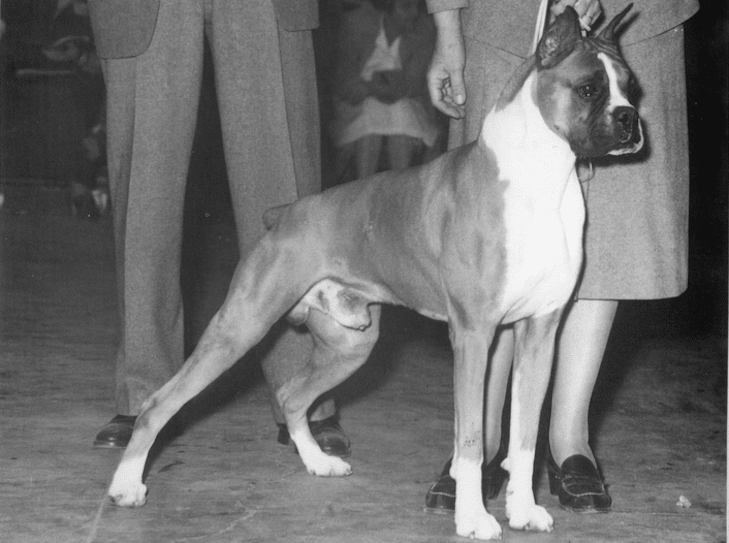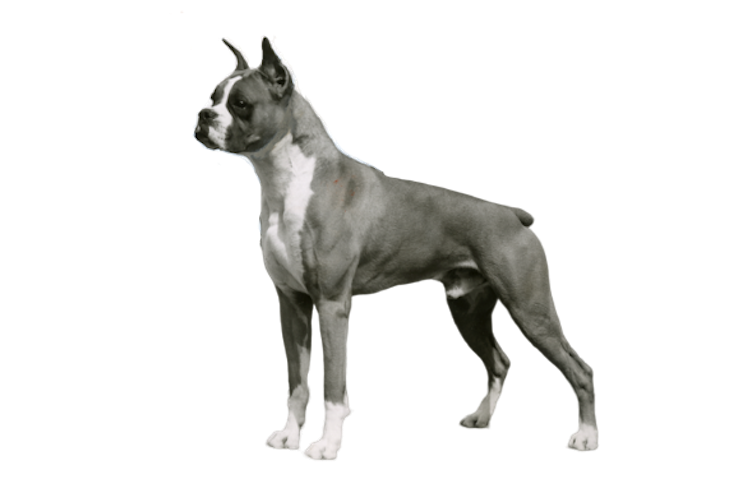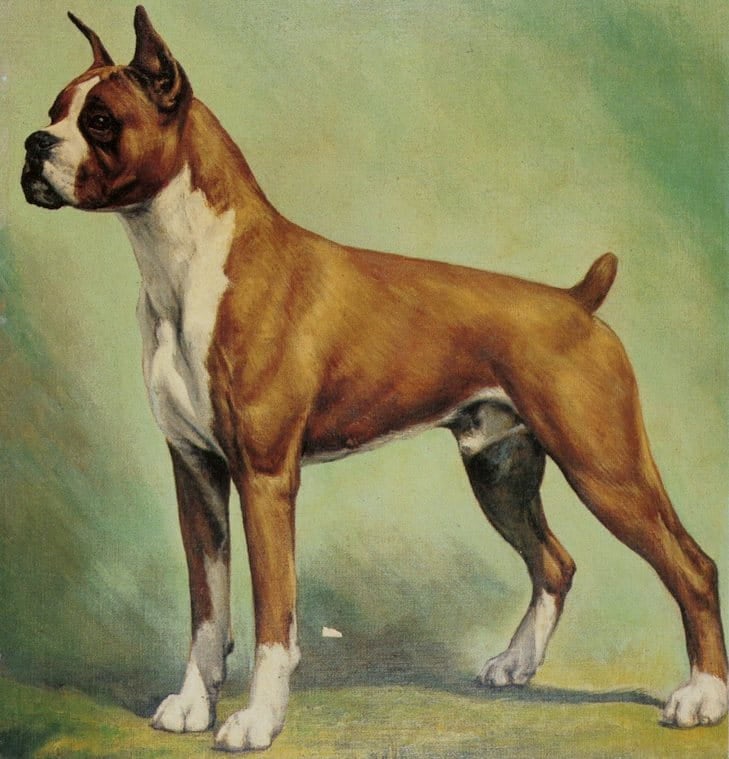
Dogs require a degree of sacrifice, which owners happily make for the pleasure of having them in our lives. We invest in quality veterinary care and the best dog food we can afford. We buy lint rollers in bulk and learn to live with saliva streaks on our glass doors and windows. And we scooch over on the couch to make space for our snuggly four-legged shadows. But to understand just how much one person can give up in the name of the breed they love, consider Friederun von Miran-Stockmann. A German breeder and artist, she almost single-handedly stabilized Boxer type in its homeland, nurturing the still-developing breed through the miseries of not one but two World Wars.
When sheer persistence was not enough to stave off starvation on her increasingly hardscrabble Bavarian farm, Stockmann regretfully sold her best dogs abroad. This ensured that her bloodline would survive, and indeed, thrive, on a far-away continent. As Stockmann sent her dogs across the Atlantic, she unwittingly sowed the seeds of the modern American Boxer. The culmination came in Ch. Bang Away of Sirrah Crest, who took Best in Show at Westminster in 1951, and is still revered as the greatest Boxer ever to step paw in an American show ring.
Altogether too few fanciers know that without Stockmann and her famous vom Dom kennel, Bang Away would have never existed. Chances are, neither would the elegant, showy American Boxer that we know and appreciate today.
Boxers In Bavaria
Born in Latvia into a family of relatively wealthy ethnic Germans – her father a doctor, her mother an artist – Stockmann was not permitted to have a dog.
“It’s possible that my whole life would have been different if that childhood wish had been fulfilled,” she mused in her 1960 memoir, Ein Leben mit Boxern (My Life With Boxers). “Instead, my existence was stamped and shaped by this childhood dream.”
As a child, Stockmann saw two statues of black-masked fawn Pugs at a Christmas market, becoming so enraptured with them that the vendor lowered the price so she could afford them. The ceramic Pugs sat on her night table, occasionally trotting through her dreams and presaging the larger, similarly flat-faced dogs to come.
In one of her brother’s books, Stockmann eventually read the description of what was described as the German cousin to Britain’s Bulldog.

“The Boxer breed in those days was still fighting for its existence,” she remembered later. “Indeed, there was a young club for its breeders. But there was no clarity about breeding guidelines. Munich was almost the sole residence of the Boxer, and very seldom did a buyer succeed in bringing a Boxer to the world outside of Munich.”
When she turned 18, Stockmann was sent to art school in – you guessed it – Munich. There, she fell in love twice. First with Pluto, a dog that had “a big head, a black face and a coat like a tiger,” and then with the brindle Boxer’s owner, a young man named Philipp Stockmann, who eventually became her husband.
Registered with the German Kennel Club, Pluto became the first Boxer to carry the “vom Dom” suffix, which literally means “from the cathedral.” While some of her competitors later complained that the choice was a pretentious one, Stockmann confided that it came from Pluto’s tendency to chase other dogs and cats around the huge church near her mother-in-law’s house.
Becoming Boxer Breeders
The newlyweds settled down in the countryside outside of Munich, and Stockmann began breeding in earnest. She supplemented her income by casting and carving sculptures of Boxers and other breeds that today are hotly sought after by art lovers and collectors. Studying the materials produced by the Munich Boxer Club, she began to realize that Pluto, with his long back and steep hindquarters, was far from the ideal specimen. Eventually, using the remainder of her dowry that was intended for new furniture, she purchased Rolf von Vogelsberg, a big winner of the day and successful sire. So successful, in fact, that according to Stockmann, there is no Boxer alive who does not have him in its pedigree.
Pluto, for his part, took to terrorizing the neighborhood, brawling with other dogs and bringing down game so unrepentantly that Stockmann was forced to find him a new home.
“I always had a guilty conscience over being unfaithful to Pluto,” Stockmann wrote. “Later, when I had to give up one of my dear Boxers too soon, I had the feeling that it was a type of punishment for not being true to my first Boxer, who always remained mine in my heart.”
When World War I dawned, Philipp Stockmann was called to military service. He later returned to collect ten of the vom Dom Boxers, including the famous Rolf, which were needed to deter snipers at the front. Left alone at home with their infant daughter and remaining dogs, Stockmann fed the latter by rummaging for scraps in garbage bins outside of military barracks and pedaling tens of miles on her bicycle to buy cow intestines.
Vom Dom Across The Atlantic

Just before the Great War, the Stockmanns had exported their first dog to the U.S., Dampf von Dom, who became the first American champion in 1915. After peace was declared, Philipp returned home with a gray-faced Rolf. Friederun, meanwhile, continued to get offers from wealthy American fanciers as she struggled to fend off unknown livestock diseases, as well as increasing interference from the burgeoning Nazi government. To survive, she exported three of her best dogs to America. Among them were a promising young male, Utz vom Dom, his stunning grandfather, Sigurd vom Dom, and another Sigurd grandson, the brindle Dorian vom Marienhof. But Stockmann reassured herself with the thought that she had kept the best for herself, Utz’s older brother, Lustig von Dom.
With World War II percolating on the horizon, yet another American broker arrived, offering the unheard-of sum of 13,000 marks for Lustig. Stockmann could not imagine selling the dog – “the sunshine of our home” – but the money would enable her to buy a car.
“A thousand thoughts raced through my grieving mind,” she wrote after agreeing to the 1937 sale, which she immediately regretted. “I even seriously considered pulling off a swindle and shipping another dog. Who would know the difference? I could paint more markings on Lustig and hide him for the rest of his life. Or maybe it would be possible to follow Lustig’s crate and release him at night from his strange kennel. One call from me, and there wouldn’t be a fence high enough to keep him from my side.”
Wearing a collar that read Ich Bin Der Herrliche Lustig (“I am the magnificent Lustig”), Stockmann’s masterwork of breeding left for America. Her last glimpse of him was in his crate as he headed to the railway station, his leash dangling forlornly from his mouth as if he knew what lay ahead. As for that much-needed car, the Nazis soon confiscated its battery and tires for the war effort.
With the arrival of Lustig in America, the so-called “Four Horsemen” of the American Boxer were in place. Understanding the quality and value of this quarter of vom Dom dogs, clever American Boxer breeders worked the pedigrees that Stockmann had so painstakingly developed. They continued to pursue her vision of a robust but undeniably elegant canine athlete.
Only a handful of years after the war ended, Stockmann was invited to judge in America. Her visit was underwritten by the wealthy American kennels of the day, including Mazelaine and Sirrah Crest. As she traveled from East to West coast, Stockmann was overwhelmed by the luxuries of modern American life, from air-conditioned homes to acres of rolling lawns. But her greatest jolt came at a match show in California, where amid the 90 puppies, she was overcome by a strong sense of déjà vu.
Bang Away

“Among the male Boxers, a little fellow immediately caught my eye, a fawn with white markings and white socks,” she remembers. “That’s Lustig, I thought. But a closer look showed that he was not quite the same. Lustig was more powerful, his head more sharply chiseled. Yet the grand pose and the long graceful neck brought back memories of this puppy’s great ancestor.”
Stockmann nicknamed the promising puppy “little Lustig,” but devotees of Boxers know him as none other than the famous Bang Away. As he matured, this showy fawn dog more than fulfilled expectations in both the whelping box and the show ring. Setting the template for the breed, Bang Away became both its top producer and most successful showman, the first dog of any breed to crack the ceiling of 100 Bests in Show, including one of the most prestigious, Westminster in 1951.
For many American fanciers, Bang Away’s stylish, streamlined look, which has come to define the breed on these shores, was new and exciting. But for those who understood his roots, the Bang Away phenomenon was more about preservation than innovation. It was the culmination of the endless sacrifices of a visionary breeder in the far-away Bavarian countryside. In the long run, Friederun von Miran-Stockmann’s losses were, perhaps more than anyone can imagine, the American Boxer’s invaluable gain.

